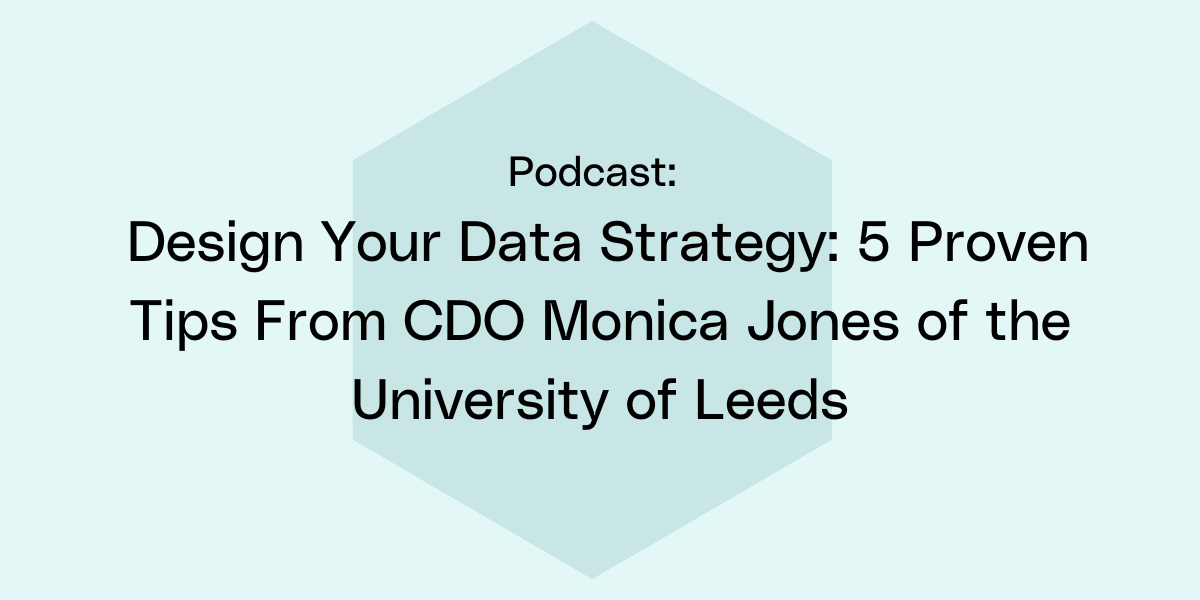Despite increased investments in data and analytics, many companies still can’t unlock their data’s full potential. A solid data strategy framework can help change that.
Despite increased investments in data and analytics, many companies still face challenges like siloed data, poor management practices, and unreliable insights, preventing them from fully unlocking their data’s potential. A solid data strategy framework can help overcome these obstacles and guide organisations toward becoming more data-driven.
In a recent episode of the Data & AI Mastery podcast, we were joined by Monica Jones, Chief Data Officer (CDO) at the University of Leeds. Monica is currently leading the development and execution of the University’s Data Strategy and has extensive experience driving change through data.
In this post, we will highlight Monica's five crucial insights for designing a winning data strategy that you can apply to your business.
Connect Data Strategy With Business Goals
To make a real change, you need a framework. Without it, you're just replacing chaos with chaos. This is the core purpose of a data strategy—ensuring that everyone on the team understands the broader business goals and the direction you're heading.
For this to happen, your data strategy must be closely aligned with your overarching business objectives.
Monica says, “People get terribly excited, do a project, chuck it over the fence, and go, ‘Woohoo, there you go, get on with it.’ So, what you've got to do is always put that proverbial cart before the horse, to then be able to say, ‘Right, okay, this is where it's going to safely land,’ and by doing that, you've got a much better chance of success.”
Without this alignment, your data efforts risk becoming ineffective or even a burden.
Create a Centralised Operating Model
One of Monica’s key tips for a successful data strategy is to implement a centralised operation model.
A centralised operating model offers a more structured approach, with all responsibilities falling under a specific executive function. This setup enables proactive data governance and enhances decision-making efficiency.
She explains, “We need to create a central data service. It's got to be somebody's day job to do this. Otherwise, you're just pushing it on the side of the desk of already very busy people.”
Keep It Simple
When designing a data strategy framework, it’s crucial to keep it goal-oriented and as simple as possible. Remember that the framework is there to simplify things for you, not make them more complicated. That’s why Monica has a simple rule: keep it concise.
She emphasises, “Never make it any longer than ten pages 'cause nobody will read it. But actually, it sort of works. It's a bit like the standard data set in the NHS. The optimum size of a data set is about a hundred data items, because that's essentially the size of a Pokemon deck. And the human brain can actually retain that amount of information of a hundred data items and the metadata and the attributes.”
Create Accountability
When Monica stepped into her role as the CDO, she took the decision to make the data transformation project at the University of Leeds publicly available. One of the key reasons was to create accountability within the data team.
It’s all about showing commitment and dedication to a shared goal. As she explains, “The commitments are there everything from some of the technological sort of delivery and to actually helping colleagues to make data-driven decisions, turning that burden into an asset and actually linking it into our overarching strategy. I think you've got to have that kind of commitment and also the determination to succeed.”
Keep Track of Progress
Finally, keep your eyes on the end goal but remain adaptable throughout the process.
Being flexible means you can respond quickly to changing circumstances while still regularly checking progress against the plan.
Monica explains, “There's a bit of testing and adjusting as you go along, and it's about not being put off when you hit some of the buffers, perhaps some of the resistance, perhaps some of the sort of things that don't quite happen in the order that you'd anticipated them [...] but also continuing to play back what the progress is against the plan and just being honest and upfront about it.”
And there you have it! Those are the five most crucial steps to consider when building and executing your data strategy. By following these tips, you can unlock the full potential of your data and drive meaningful change.
So, take Monica's advice, tailor them to your business, and start turning your data into the powerful asset it’s meant to be!

-1.png)

